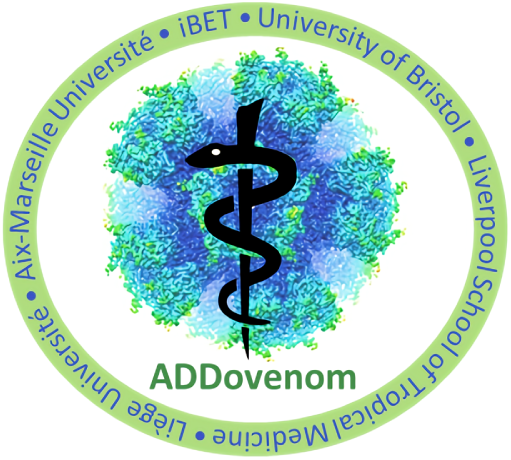Research
Technical Research Objective

“To achieve these ambitious goals, ADDovenom combines unique expertise across a range of techniques and scientific disciplines, towards developing easy to produce, first-in-class neutralizing superbinders for snakebite therapy.”
ADDovenom initiates a major multidisciplinary effort to achieve a timely step-change in snakebite therapy, by creating an innovative platform with transformative potential for antivenom generation to save countless lives. ADDovenom exploits a disruptive new, protein-based nanoscaffold – the ADDomer© – a megadalton sized, thermostable synthetic virus-like particle that offers 60 high-affinity binding sites to rapidly eliminate venom toxins from the blood stream. We will deploy ADDobody, a small, stable protein motif with randomized flexible loops that will be utilized as a naïve library to select and evolve high-affinity binders in vitro by Ribosome Display.
The ADDovenom project brings to bear cutting-edge proteomics, transcriptomics and bioinformatics to inventorise the toxin repertoire of eight snakes that inflict the most clinically-challenging envenoming syndromes in sub-Saharan Africa: haemorrhage, coagulopathy, paralysis and tissue necrosis. We will implement rational design and high-throughput expression to produce antigens for our selections, based on the major toxin groups we target. We will design consensus-toxins and epitope strings combining conserved sequences, to achieve maximal intergeneric efficacy of our ADDobody binders, boosting neutralizing efficacy for entire toxin families simultaneously. We will develop state-of-the-art bioprocessing to manufacture ADDomer©-based antivenoms at pharma scale, preparing for future clinical trials.
Project Aims
The Challenge: A neglected tropical disease
The first-choice treatment of snakebite envenoming is antivenom and yet snake bites still cause up to 138,000 deaths and 400,000 disabilities every year in surviving victims. This burden primarily affects the most economically and medically disadvantaged farming communities of Asia, sub-Saharan Africa and Latin America. Current anti-venoms are based on antibodies from hyperimmunised horses and sheep; an approach implemented in 1896 by Albert Calmette. These antivenoms are only weakly effective: Only approximately 10-15% of the antibodies bind venom, and multiple vials are needed to effect cure, but each additional vial induces higher levels of adverse effects and increases treatment costs.
This approach has many additional disadvantages, in particular it cannot rationally incorporate the distinct immunogenicity or toxicity of the venoms’ proteins into the design (venoms comprise between 20 to >100 proteins that vary in molecular mass, bioactivity and pathogenicity). This is particularly problematic because snake venoms and their toxins vary significantly at every taxonomic level, and highly pathogenic, diverse and low-molecular mass toxins are notoriously poor immunogens.


An innovative solution requiring proof-of-principle validation:
The ADDoVenom consortium propose a radical, innovative change to snakebite treatment by rationally designing antivenoms to bind and neutralise the pathogenic function of all toxins of the medically most important snakes, irrespective of taxonomy or geography, and without adverse effect risk.
We will achieve this by applying cutting-edge analysis techniques to snake venoms to enable informed target choices, by establishing new protein engineering tools, and high-throughput production methods. Based on non-conventional techniques and designs, new protein-based nanoparticles – ADDobodies and ADDomers© – will be implemented with cost-effective technologies and compatible with industrial processes and quality control.
Research Institutes
ADDovenom Work Packages
Mass
spectrometry
and
bioinformatics
to analyse venoms
In vitro
evolution
and
characterization
of
ADDobody binders
Examination of neutralizing ability of selected ADDobodies
and gigabodies
Scalable bioprocess
for
gigabody production
bullets
Characterisation of crude venom’s complexity
Generate a toxin database
Identification and selection of the most potent toxins target
Bioinformatics tools for antigen design
Purify known and new toxins
Pharmacokinetic characterisation of ADDobodies
Standard toxicity tests of ADDobodies
Test functional ability of ADDobodies to neutralise toxin-function
Pharmacokinetic characterisation of ADDobodies
Standard toxicity tests of ADDobodies
Production of gigabodies: Baseline process
Process development
Production of gigabodies: Optimized process

